november 2nd, 2010
Tomás Saraceno
Iridescent Plant Medium with Lamp, 2009
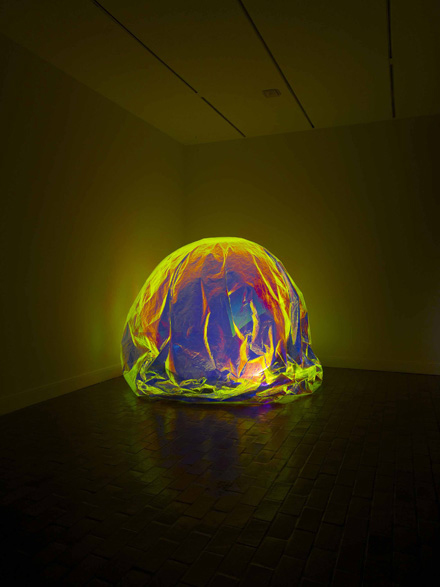
The luminous and roughly human-height Iridescent Plant Medium with Lamp consists of a sphere dressed in a billowing sheath of iridescent foil in a dark room. Thoroughly otherworldly, the orb shivers and cowers in the corner like a specimen from space. NASA, it should be noted, sent plants on early space missions and began experimenting with aeroponics in the late 1990s. One can imagine the possibility of future cosmic plantations, a vision clearly encouraged by Saraceno’s installation.- Based on a text by Erin Rouse –
Sunny Day, Air-Port-City, 2006
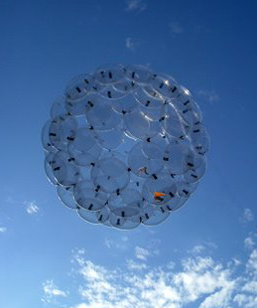
As an architect Saraceno has for years been looking into the possibility of using large balloon-like constructions to enable the free circulation of persons and goods across the entire globe.
Posted in Cosmology, Photobiology, Visual Arts | Reacties uitgeschakeld voor Air-Port-City
november 7th, 2009
Martin Walde
AHIS, 2009
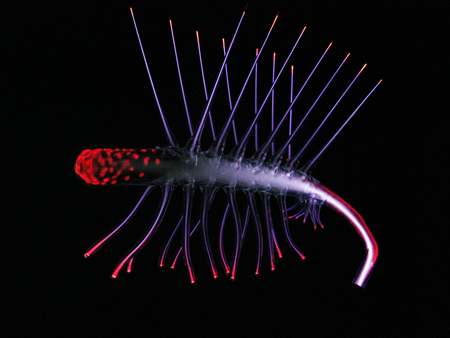
Thin walled glas bodies, filled with several different gases, are made to shine through high frequency technology. They are made to look like ancient small animals millions of years old which have been found in Kanada in 1977. S.C. Morris discovered these animals and called them “Hallucigenia”.
Posted in Photobiology, Visual Arts, Zoology | 1 Comment »
november 7th, 2009
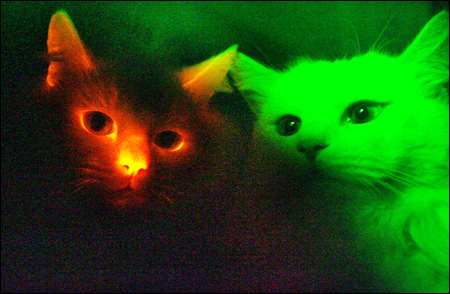
South Korean scientists have cloned cats that look reddish under ultraviolet light by modifying a protein gene to change their skin color.
The team at Gyeongsang National University produced three Turkish Angora cats possessing altered fluorescence protein (RFP) genes.
The Ministry of Science and Technology said, “It marked the first time in the world that cats with RFP genes have been cloned. The ability to produce cloned cats with the manipulated genes is significant as it could be used for developing treatments for genetic diseases and for reproducing model (cloned) animals suffering from the same diseases as humans.”
Posted in Photobiology, Zoology, Zootechnics | Reacties uitgeschakeld voor Black Cat / White Cat
februari 25th, 2009
Maarten Vanden Eynde
Platic Reef – sample, 2009
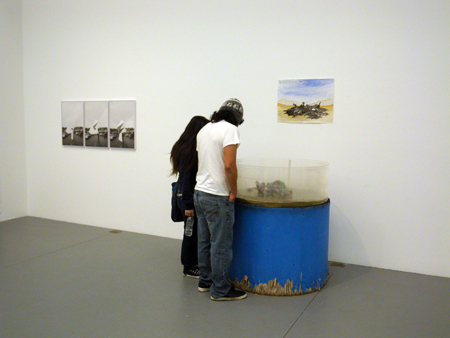
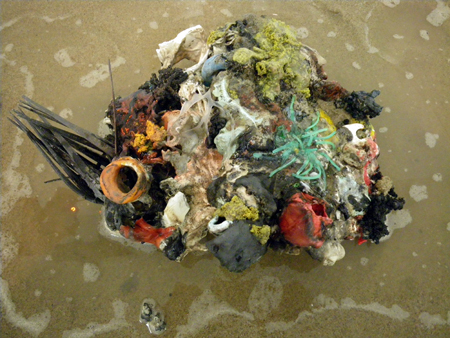
THIS IS THE FUTURE BEFORE IT HAPPENED…
(title of exhibition curated by Julie Deamer – Glendale, USA, 02/2009)
A “floating landfill”, twice the size of Texas and made up of plastic particles was swirling about 1,000 miles west of California and 1,000 miles north of the Hawaiian Islands. The trash collected in one area, known as the North Pacific Gyre, due to a clockwise trade wind that circulated along the Pacific Rim. While the plastic trash floated along, instead of biodegrading, it was “photodegrading,” — the sun’s UV rays turned the plastic brittle, much like they would crack the vinyl on a car roof. They broke down the plastic into small pieces and, in some cases, into particles as fine as dust.
Charles Moore, marine researcher at the Algalita Marina Research Foundation in Long Beach who discovered the plastic in 1997 and has been studying and publicizing the patch for the past 20 years, said the debris — which he estimates weighed 3 million tons and covered an area twice the size of Texas —was made up mostly of fine plastic chips and impossible to skim out of the ocean. Also, it was undetectable by overhead satellite photos because 80 percent was plastic and therefore translucent. The plastic moved just beneath the surface, from one inch to depths of 300 feet, according to samples Moore collected .
Ironically, the debris was re-entering the oceans whence it came; the ancient plankton that once floated on Earth’s primordial sea gave rise to the petroleum, being transformed into plastic polymers. That exhumed life, our “civilized plankton,” was, in effect, competing with its natural counterparts, as well as with those life-forms that directly or indirectly fed on them. Inside the North Pacific Gyre the natural plankton was outnumbered 6 to 1 in favor of the plastic plankton. The scale of the phenomenon was astounding. Plastic debris became the most common surface feature of the world’s oceans. What could be done with this new class of products made specifically to defeat natural recycling? How could the dictum “In ecosystems, everything is used” be made to work with plastic ? So far no organism was able to digest plastik plankton or transform it again into something organic, closing back the broken chain of life.
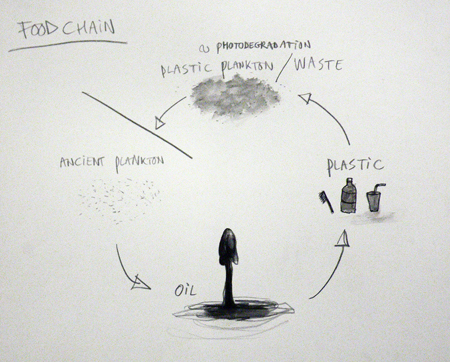
In February 2010 the Belgian artist Maarten Vanden Eynde (1977), based in Rotterdam, The Netherlands, went to the North Atlantic Gyre with a boat to collect 5 tons of plastic debris. He melted it into a huge plastic coral reef and shipped it to Oman. There, in the middle of a dried out sea, located in a dessert called ‘Mother of All Poisons’ (due to the hazardous environmental conditions), he placed the new coral reef as a landart sculpture, a remnant of a forgotten present discovered in a possible future.
Posted in Ecology, Oceanography, Photobiology, Visual Arts | Reacties uitgeschakeld voor THIS IS THE FUTURE BEFORE IT HAPPENED…
januari 31st, 2007
Jelte van Abbema
Symbiose, 2006
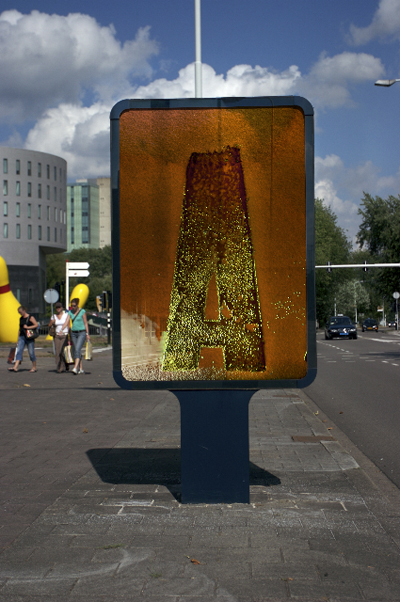
Printed media can create a harmful impact to the environment. Solutions like soy ink and natural pigments are a better alternative, but Jelte van Abbema takes this approach even further. His fascination for nature allows him to investigate the possibilities of bacteria in a visual culture. To stay within scientific guidelines, he completed a course at the department of microbiology at the University of Wageningen. The result is a radical concept within printed media in that the image is still materializing when it rolls off the press. By converting a bus stop poster box (manufactured by JCDecaux) with controlled conditions, van Abbema creates an environment for his print to thrive. With time, the bacteria transform and begin to shape their own aesthetics and dimensions by growing over their printed boundaries.
Posted in Photobiology, Visual Arts | Reacties uitgeschakeld voor Bacteriologic symbiosis
december 4th, 2006
davidkremers
paraxial mesoderm, 1992
agar, x-gal, iptg, neutral red n-2880, ecoli tb-1, synthetic resin on acrylic plate
24 x 24 inches
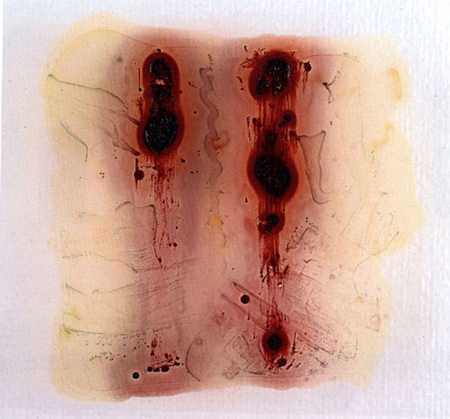
©davidkremers1992
abstract
given evolution as a step of physiology based intelligence.
method paintings are grown on plates of clear acrylic using bacteria genetically engineered to produce enzymes of various colors after maturation, the plates are dried and sealed in a synthetic resin the figurative subjects are chosen from embryonic structures common to all mammals.
q e d life is organization rather than substance. consciousness is inherent in the way molecules are organized, not in the substance of the molecules themselves.
visceral arch, 1992
gesso, eosin y, agar, x-gal, iptg, ecoli tb-1, plasmid, alizarin red-s, synthetic resin on acrylic plate
24 x 24 inches
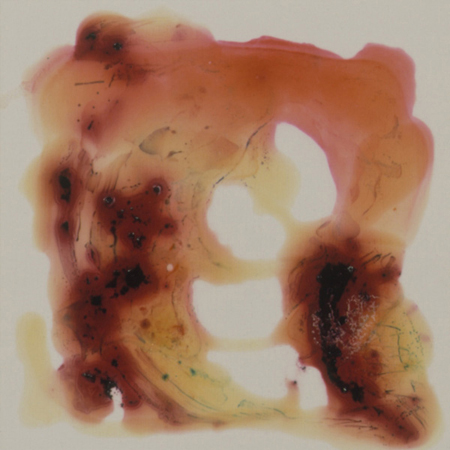
©davidkremers1992
‘in 1992 i began growing paintings from bacteria on plates of clear acrylic, using bacteria that was genetically engineered to produce enzymes of various colors. itís like painting on a piece of ice with melted snow. after eighteen hours in an incubation chamber the image grows into the shapes and colors the bacteria and i have collaborated on. the plates are then dried and sealed in a synthetic resin. future conservators, a millenium away, may remove the resin, feed the bacteria, and continue the life of the work. the figurative subjects were chosen from early embryonic structures common to all mammals. evolution as a step of physiology-based intelligence’.
Posted in Photobiology, Visual Arts | Reacties uitgeschakeld voor Embryonic Section Paintings









